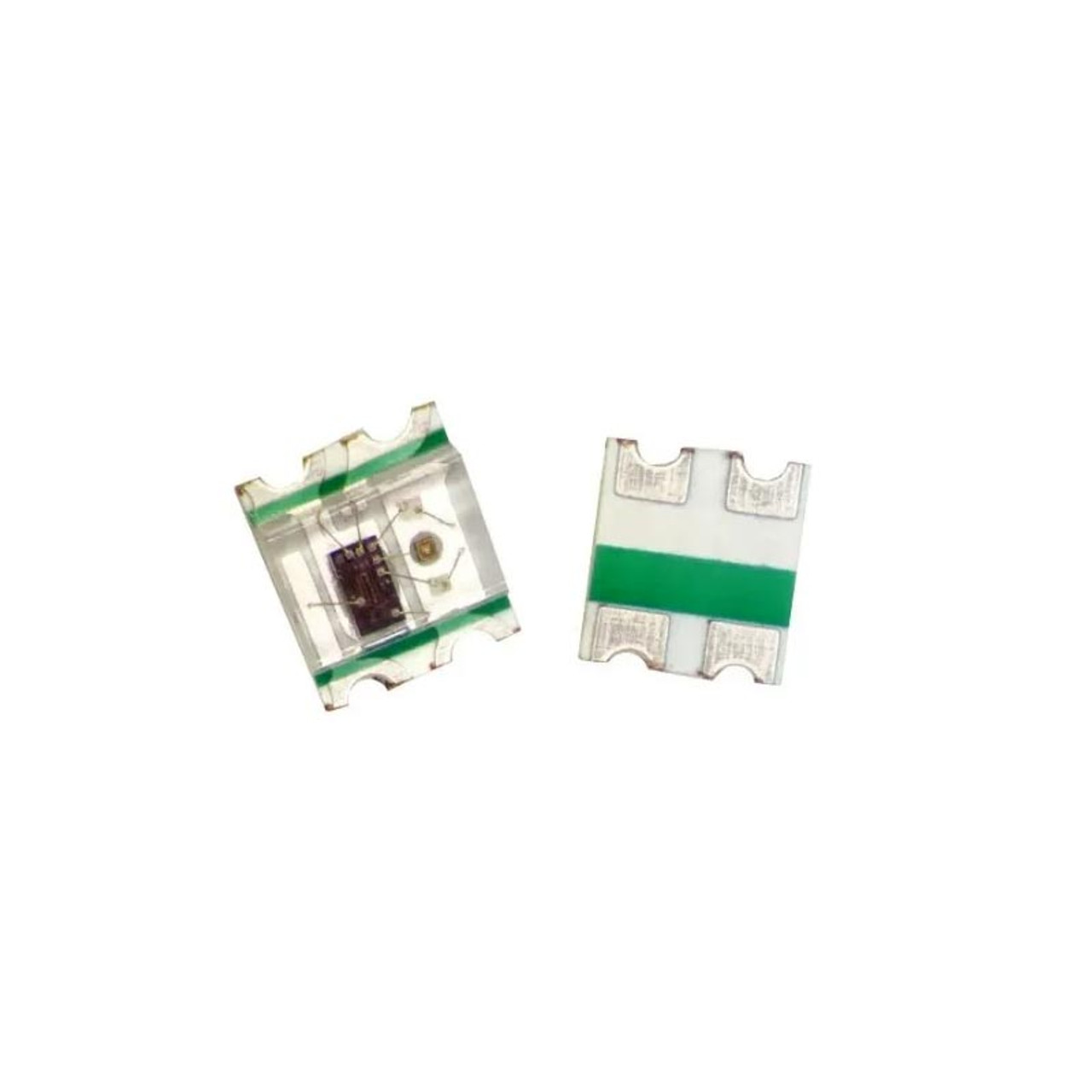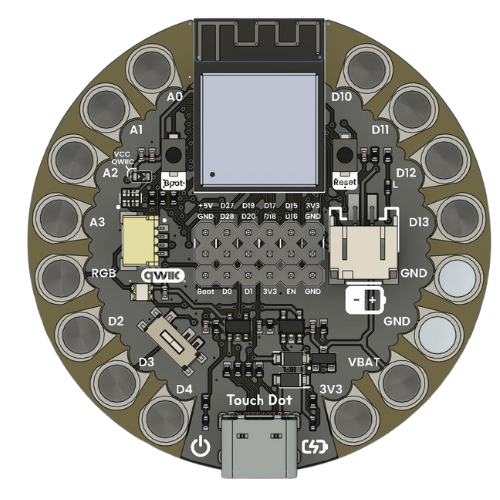WS2812-2020 Control#
The WS2812-2020 is a compact RGB LED that can be precisely controlled using the Touch Dot S3 board. This section provides technical guidance for driving WS2812 LEDs and generating custom lighting patterns with MicroPython, C++, and ESP-IDF.
On the Touch Dot S3, a dedicated GPIO pin (GPIO45) is directly connected to the WS2812 LED, allowing for straightforward hardware interfacing and reliable signal timing.
PIN |
GPIO ESP32-S3 |
|---|---|
DIN |
45 |

Fig. 18 WS2812-2020 LED Strip#
Note
The neopixel library is compatible with WS2812 and WS2812B LED strips. The WS2812-2020 is a variant of the WS2812B, so it is fully compatible with the neopixel library.
Code Example#
Below is an example that demonstrates how to control WS2812-2020 LED strips using the Touch Dot S3 board
from machine import Pin
from neopixel import NeoPixel
np = NeoPixel(Pin(45), 1)
np[0] = (255, 128, 0) # set to red, full brightness
np.write()
#include <Adafruit_NeoPixel.h>
#define PIN 45 // Cambia si GPIO45 no funciona
#define NUM_LEDS 1 // Número de LEDs en tu tira
Adafruit_NeoPixel strip(NUM_LEDS, PIN, NEO_GRB + NEO_KHZ800);
void setup() {
strip.begin();
strip.show(); // Apaga todos los LEDs al inicio
}
void loop() {
// Ciclo de colores
strip.setPixelColor(0, strip.Color(255, 0, 0)); // Rojo
strip.show();
delay(1000);
strip.setPixelColor(0, strip.Color(0, 255, 0)); // Verde
strip.show();
delay(1000);
strip.setPixelColor(0, strip.Color(0, 0, 255)); // Azul
strip.show();
delay(1000);
}
/*
* SPDX-FileCopyrightText: 2021-2022 Espressif Systems (Shanghai) CO LTD
*
* SPDX-License-Identifier: Unlicense OR CC0-1.0
*/
#include <string.h>
#include "freertos/FreeRTOS.h"
#include "freertos/task.h"
#include "esp_log.h"
#include "driver/rmt_tx.h"
#include "led_strip_encoder.h"
#define RMT_LED_STRIP_RESOLUTION_HZ 10000000 // 10MHz resolution, 1 tick = 0.1us (led strip needs a high resolution)
#define RMT_LED_STRIP_GPIO_NUM 45
#define EXAMPLE_LED_NUMBERS 24
#define EXAMPLE_CHASE_SPEED_MS 10
static const char *TAG = "example";
static uint8_t led_strip_pixels[EXAMPLE_LED_NUMBERS * 3];
/**
* @brief Simple helper function, converting HSV color space to RGB color space
*
* Wiki: https://en.wikipedia.org/wiki/HSL_and_HSV
*
*/
void led_strip_hsv2rgb(uint32_t h, uint32_t s, uint32_t v, uint32_t *r, uint32_t *g, uint32_t *b)
{
h %= 360; // h -> [0,360]
uint32_t rgb_max = v * 2.55f;
uint32_t rgb_min = rgb_max * (100 - s) / 100.0f;
uint32_t i = h / 60;
uint32_t diff = h % 60;
// RGB adjustment amount by hue
uint32_t rgb_adj = (rgb_max - rgb_min) * diff / 60;
switch (i) {
case 0:
*r = rgb_max;
*g = rgb_min + rgb_adj;
*b = rgb_min;
break;
case 1:
*r = rgb_max - rgb_adj;
*g = rgb_max;
*b = rgb_min;
break;
case 2:
*r = rgb_min;
*g = rgb_max;
*b = rgb_min + rgb_adj;
break;
case 3:
*r = rgb_min;
*g = rgb_max - rgb_adj;
*b = rgb_max;
break;
case 4:
*r = rgb_min + rgb_adj;
*g = rgb_min;
*b = rgb_max;
break;
default:
*r = rgb_max;
*g = rgb_min;
*b = rgb_max - rgb_adj;
break;
}
}
void app_main(void)
{
uint32_t red = 0;
uint32_t green = 0;
uint32_t blue = 0;
uint16_t hue = 0;
uint16_t start_rgb = 0;
ESP_LOGI(TAG, "Create RMT TX channel");
rmt_channel_handle_t led_chan = NULL;
rmt_tx_channel_config_t tx_chan_config = {
.clk_src = RMT_CLK_SRC_DEFAULT, // select source clock
.gpio_num = RMT_LED_STRIP_GPIO_NUM,
.mem_block_symbols = 64, // increase the block size can make the LED less flickering
.resolution_hz = RMT_LED_STRIP_RESOLUTION_HZ,
.trans_queue_depth = 4, // set the number of transactions that can be pending in the background
};
ESP_ERROR_CHECK(rmt_new_tx_channel(&tx_chan_config, &led_chan));
ESP_LOGI(TAG, "Install led strip encoder");
rmt_encoder_handle_t led_encoder = NULL;
led_strip_encoder_config_t encoder_config = {
.resolution = RMT_LED_STRIP_RESOLUTION_HZ,
};
ESP_ERROR_CHECK(rmt_new_led_strip_encoder(&encoder_config, &led_encoder));
ESP_LOGI(TAG, "Enable RMT TX channel");
ESP_ERROR_CHECK(rmt_enable(led_chan));
ESP_LOGI(TAG, "Start LED rainbow chase");
rmt_transmit_config_t tx_config = {
.loop_count = 0, // no transfer loop
};
while (1) {
for (int i = 0; i < 3; i++) {
for (int j = i; j < EXAMPLE_LED_NUMBERS; j += 3) {
// Build RGB pixels
hue = j * 360 / EXAMPLE_LED_NUMBERS + start_rgb;
led_strip_hsv2rgb(hue, 100, 100, &red, &green, &blue);
led_strip_pixels[j * 3 + 0] = green;
led_strip_pixels[j * 3 + 1] = blue;
led_strip_pixels[j * 3 + 2] = red;
}
// Flush RGB values to LEDs
ESP_ERROR_CHECK(rmt_transmit(led_chan, led_encoder, led_strip_pixels, sizeof(led_strip_pixels), &tx_config));
ESP_ERROR_CHECK(rmt_tx_wait_all_done(led_chan, portMAX_DELAY));
vTaskDelay(pdMS_TO_TICKS(EXAMPLE_CHASE_SPEED_MS));
memset(led_strip_pixels, 0, sizeof(led_strip_pixels));
ESP_ERROR_CHECK(rmt_transmit(led_chan, led_encoder, led_strip_pixels, sizeof(led_strip_pixels), &tx_config));
ESP_ERROR_CHECK(rmt_tx_wait_all_done(led_chan, portMAX_DELAY));
vTaskDelay(pdMS_TO_TICKS(EXAMPLE_CHASE_SPEED_MS));
}
start_rgb += 60;
}
}
Tip
for more information on the NeoPixel library, refer to the NeoPixel Library Documentation.
